Purpose This study is a phenomenological research which tries to describe the subjective experience and to analyze multi-layered meanings, and it finds out the men's training experience and meaning. The purpose of this study is to investigate why the men do Yoga and what the subjective meaning of Yoga experience, and the study examines critically whether Yoga experience especially focused on women is against gender performance and dominant body discourse. Methods For the study, 6 middle & young-old aged men who do Yoga more than 6 months every week are selected as participants. Results The meaning of Yoga for middle & young-old aged men in their lives is as follows. First, it is hard for men to experience Yoga because of social and cultural background. Finding Yoga class which takes men's membership is difficult. Second, middle & young-old aged men's physical feature(interest in their health and disease) and personal background(women friendly daily life) become specific motivation to overcome the barrier to do Yoga. Third, Yoga is 'alterative training', not a training. Yoga is considered as a training which replaces the feature of training called men's sports previously. Fourth, Yoga has a meaning of 'healing' to have our own time. Fifth, Yoga is changed by itself in Yoga culture which is focused on women even though middle & young-old aged men do Yoga for a long time. Sixth, middle & young-old aged men realize that the feature of Yoga is not 'for only women', and they thought it is 'neutral training that men can do too.' Conclusion Consequently, the reason why middle & young-old aged men do Yoga is started from the motivation regarding physical characteristics and personal background, and the main purpose is to cure and to heal our bodies and mind. For them, Yoga means 'alternative training to fit their bodies' and 'their own time'. Moreover, old male adult's training experience and meaning are against gender performance in that it cause a crack in stereotyped gender sports area, but it is notable that there is no intention to resist the dominant gender body discourse.

The purpose of this research was to investigate the difference in decision making and perceived eye-focus location on peripheral vision and attacker's expertise in basketball tactical game. A total of twenty four subjects who were expert guard players (n=8), expert basketball center players (n=8), and novices (n=8), participated in this experiment. All subjects participated two tasks. The first task was to anticipate the attack direction after viewing a sequence of basketball tactic film. These films simulated three situations including offensive patterns. The three situations were consist of 3, 6, 9 degree peripheral vision. The second task was to express the level of confidence on their anticipation and to verbalize the perceived visual cues immediately after responding. For this research, an Eyelink eye movement system, an equipment for measuring anticipating, basketball tactic film were used. The variables on anticipation of attack direction were speed, accuracy, and the level of confidence. The acquiring process of advanced visual cues was examined through analyzing visual search strategies and perceived eye-focus location. In order to examine the difference in visual search, in decision making, and in perceived eye-focus locations as a function of expertise, data were analyzed through descriptive statistics, two-way ANOVA, and two-way MANOVA. This research had the following results. First, there was a significant difference on the search rate among the three groups. But, on the other hand, expert guard and center exhibited more fixations of shorter duration than the novices in the 6 and 9 degree condition. Second, results from the ratio of fixation time allotted to areas in the 3 degree condition revealed that experts spent more time fixating the ball-attacker(BA) than novices. The results from the ratio of fixation time allotted to areas in the 6 and 9 degree condition revealed that expert guard and center spent more time fixating the non-ball attacker(NBA) than novices. Expert guard also fixated longer on the pass attacker(PA) and meaning space(MS) than novices. Finally, experts paid attention to two or three locations simultaneously, whereas novices did to only one location such as the ball, attacker, defender, non-meaning space in all condition.

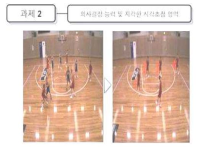
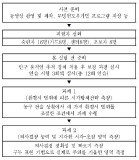
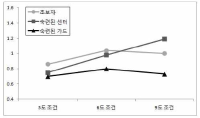

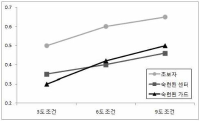

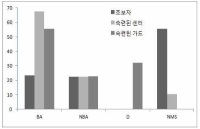
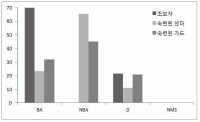
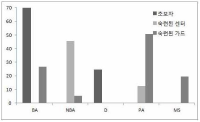
PURPOSE This study examined the effects of focus of attention on beginning golfers’ competitive anxiety and motor performance. METHODS Forty-eight college students with no prior golf putting experience were selected as participants and randomly assigned to internal-focus, external-focus, holistic-focus, and control groups (12 participants each). All subjects performed 5-m golf putting in acquisition, noncompetitive, and competitive situations. RESULTS In competitive situations, the internal-focus, holistic-focus, and control groups showed golf putting accuracy and consistency similar to those in noncompetitive situations, whereas the external-focus group’s golf putting accuracy and consistency were significantly lower in competitive situations than in noncompetitive situations. In addition, the holistic-focus group showed significantly higher golf putting accuracy than the control group in both competitive and noncompetitive situations. CONCLUSIONS Holistic-focus can be used effectively as a strategy for beginners to learn motor skills and reproduce learned motor skills when state anxiety increases. However, external attention focus cannot be considered a strategy to induce effective beginners’ exercise performance when competitive state anxiety increases.
PURPOSE This study investigated the differences in plantar pressure distribution when using three breathing techniques during heel raises. METHODS The subjects were 29 professional dancers aged 20 to 30 years with more than 10 years of experience. Pressure distribution according to breathing method during heel raise was measured for 10 seconds while controlling the raise speed and gaze. The three breathing techniques were randomly ordered. Peak pressure, contact area and time, displacement, and absolute velocity of the center of pressure trajectory were measured using Emed®-le from Novel GMBH. Plantar pressure was analyzed by dividing it into a total of 12 areas (masks): five toes, five metatarsals, the midfoot, and the hindfoot. RESULTS Using the teeth occlusion breathing technique, the peak pressure on the first metatarsal was significantly reduced, the contact time of the second metatarsal was significantly longer, and the displacement of the center of pressure trajectory was significantly shorter. Additionally, during the phase of the forefoot retainer, the velocity of the center of pressure trajectory was significantly reduced. CONCLUSIONS The teeth occlusion technique reduces peak pressure, increases contact time and area, and decreases the displacement and velocity of the center of pressure trajectory, demonstrating an efficient method for maintaining balance in ballet movements. This technique can potentially enhance stability and prevent injuries in ballet dancers.
PURPOSE This study analyzed the effect of dynamic lumbar kyphosis on the biomechnical factors affecting the lumbar joints during deep squats. METHODS Thirty adults in their 20s who had experienced weight training for more than one year participated in this study (age: 23.4±3.5years old, height: 175.3±4.3cm, weight: 75.8±6.5kg, squat single repetition maximum (1RM) weight: 115.3±19.5kg). Under both restricted dynamic lumbar kyphosis (RDLK) and dynamic lumbar kyphosis (DLK), subjects completed one repetition of deep squats at a load of 70% of their 1-RM weight. To verify the consistency of deep squat movements performed under DLK and RDLK conditions, intra-rater reliability was analyzed using intra-class correlation . The biomechnical variables of the lumbar joint were calculated during DLK and RDLK deep squats. Paired sample t-tests (IBM SPSS 27.0, Armonk, New York, USA) were used for statistical verification. RESULTS During the deep squat movement performed in DLK and RDLK conditions, the peak angles of the ankle, knee, and hip joints, the minimum height of the pelvis, and the time and tempo showed statistically high reliability, confirming the accuracy of the movement. The peak flexion angle and moment, left flexion moment, left rotation moment, and compression force factors of the lumbar joint during deep squat were significantly lower in RDLK than in DLK. CONCLUSIONS Restricting lumbar dynamic kyphosis during deep squats is essential for decreasing the risk of lumbar joint injury.
PURPOSE This study sought to analyze the velocity and asymmetry between bilateral lower extremity mechanics according to the load during walking. METHODS A total of 14 adults with right leg dominance participated in this study (Male=7, Female=7). We respectively applied 30% of body weight load carriage on the subjects. Gait characteristics were analyzed with 3-dimensional cinematography and ground reaction force (GRF) system consisted of a center of gravity (COG) velocity, center of pressure (COP) area, leg stiffness, and GRF components. RESULTS Change in velocity of the maximum-minimum COG showed statistically significant in the main effect of load. The 1st anterior-posterior GRF (braking force) and vertical GRF were statistically significant in the main effects of load and bilateral lower limbs. The 2nd anterior-posterior GRF (propulsive force) was statistically significant in the main effect of load. COP area and leg stiffness exhibited statistically significant differences in the main effects of load and bilateral lower limbs. Interaction was observed in the vertical GRF, COP area. Furthermore , one-way variance analysis revealed load main effect had a greater influence on the increase in the magnitude of the vertical GRF and COP area than the asymmetry of bilateral lower limbs. CONCLUSIONS This study revealed the differences in asymmetry between the dominant and non-dominant lower limbs according to the load during walking. These findings may explain the differences shock attenuation and stress mechanisms between the bilateral lower limbs.
PURPOSE This study aimed to understand the changes in the exercise behavior of participants in the exercise-psychological counseling program. METHODS This study sampled adult female participants of C diet camp in Seoul, who were in stages 2~3 of the “Stages of Change Model.” A total of 60 participants were randomly assigned to the counseling group (n=30) and control group (n=30). During the 12 weeks of study, all subjects participated in the diet camp program C. The counseling group participated in the exercise psychological counseling program once a week, while the control group participated in recreational activities instead. Exercise adherence, outcome-expectancy, and satisfaction were measured once every four weeks. Latent growth models were used to analyze the measured data. RESULTS Exercise adherence, outcome-expectancy, and satisfaction in the counseling group exerted a statistically significant positive effect. A statistically significant positive effect on the change of exercise adherence variable was observed in the control group, but the trend was only 1/4 of that of the counseling group. In the control group, exercise outcome-expectancy and exercise satisfaction did not have a statistically significant outcome. CONCLUSIONS The exercise counseling program is an essential intervention strategy that enhances participants’ exercise adherence, outcome-expectancy, and satisfaction. Therefore, a positive change in exercise behaviors occurs.
PURPOSE The ethical leadership of Taekwondo instructors plays a crucial role in enhancing the value of Taekwondo. Therefore, this study explores the elements of ethical leadership among Taekwondo instructors by drawing on the insights from Lao Tzu's Tao Te Ching. METHODS Through the Tao Te Ching, an oriental classic containing the ideas of Lao Tzu, we have extracted and discussed the elements of ethical leadership that Lao Tzu conveys to Taekwondo leaders in this era. RESULTS The ethical leadership of taekwondo leaders in the Tao Te Ching was presented as the virtues of inaction and humility as behavioral norms. Inaction as a code of conduct was discussed about a leader who practices inaction in a changing world through subjective thought rather than a meaningful Taekwondo leader who leads Taekwondo with an existing pattern and looks at ethics. A Taekwondo instructor must possess the virtue of humility. A Taekwondo instructor with humility must be glazed, soft, and humble as water. CONCLUSIONS In a Taekwondo culture that follows the Confucian ideology of extreme austerity, Lao Tzu's ethic of non-action and the virtue of humility can be like wearing an ill-fitting robe. However, standing on the edge, outside the frame of reference of the ideologies and values we have come to believe in and follow, and seeing the world as it is, not as it should be, according to the laws of nature, provides a new discourse for Taekwondo philosophy.
PURPOSE The purpose of this study is to analyze the biomechanical variables involved in ballet dancers’ ankle muscle imbalance when performing relevé movements. METHODS The subjects of this study (n=14, age: 22.29±1.73 years old, height: 161.4±5.06cm, weight: 51.88±7.51kg) were 14 ballet dancers with 9 years of experience. Based on the reciprocal muscle strength ratio, the dancers were divided into the following groups: Close to the normal value (RMIS) and far from the normal value (RMIB) using the maximum values of plantar flexion and dorsiflexion of the ankle joint using an isokinetic measurement equipment (60°/sec). RMIB). The biomechanical variables, namely the ankle joint movement and ground reaction force, were subsequently measured. SPSS 26.0 was used for data analysis and independent t-test was used for statistical verification. RESULTS The ground reaction force in the Z (vertical) direction based on the ankle joint muscle strength imbalance of ballet dancers was significantly lower in the RMIB group. In addition, although it was not a statistically significant difference, the plantar flexion movement was lower in the RMIB group, and there was a significant difference in the generation of ankle joint movement in the Z direction. CONCLUSIONS In conclusion, in order for a ballet dancer to efficiently utilize the force generated from the supporting leg when performing a movement, ankle imbalance must be taken into consideration when training.
PURPOSE This study aims to develop a coach presenteeism scale with scientifically proven reliability and validity. METHODS In order to achieve the research purpose, preliminary questions were drafted using previous studies (Lee & Kim, 2022) and existing presentation questionnaires (SPS-34, SPS-6, SPS-13). The preliminary set of questions was composed of 23 questions, which were deliberated through a meeting with subject experts. After which, a survey involving 183 coaches was conducted. In this study, statistical verification procedures were conducted through construct validation, exploratory factor analysis, confirmatory factor analysis, internal consistency analysis, convergent validation and discriminant validation. RESULTS Finally, a 2-factor (DRA 5 items, DTP 5 items), 10-item coach presenteeism scale was developed. CONCLUSIONS In this study, a scale with verified reliability and validity was developed to support and investigate the presenteeism phenomenon experienced by coaches. These may be used by coaches themselves to check their presenteeism status and may guide future research to effectively train athletes.